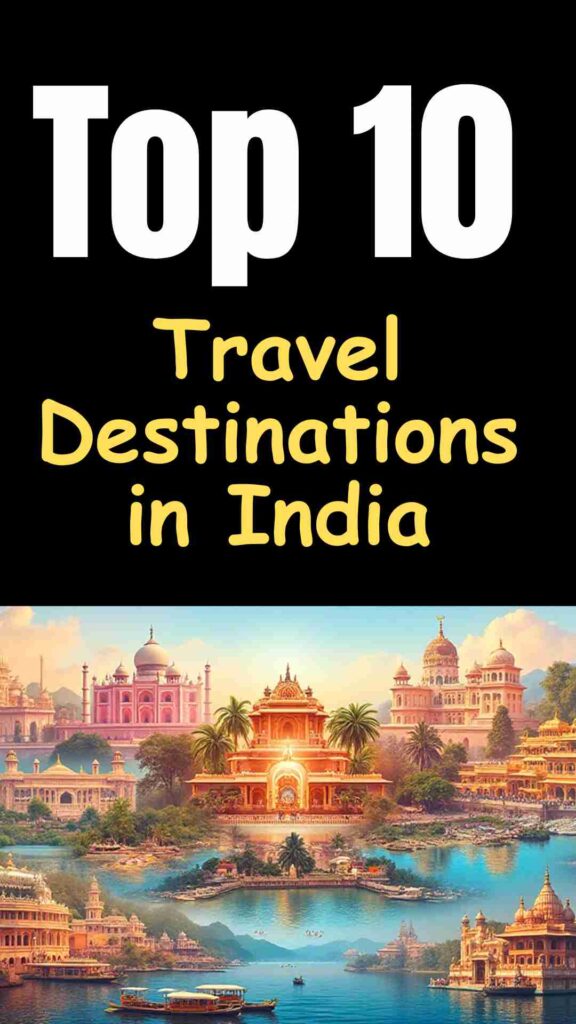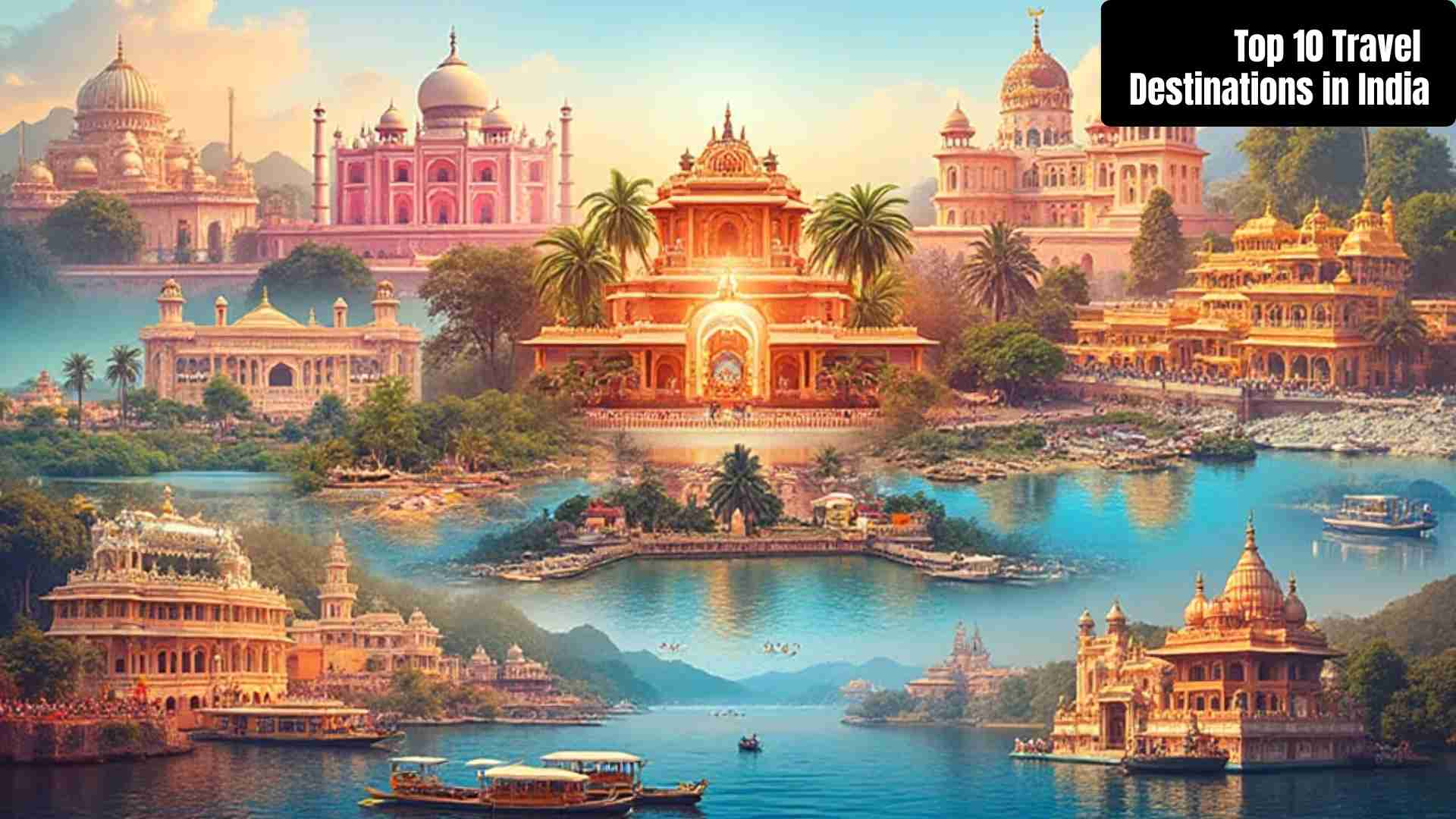India is a country that feels like a thousand journeys wrapped into one. From snowy mountains to sunny beaches, from ancient temples to buzzing modern cities, every corner has its own story. Traveling here can be overwhelming at first, but once you start exploring, it’s hard not to fall in love with the diversity.
In this guide, I’ll walk you through the top 10 travel destinations in India. Think of it less like a checklist and more like a set of experiences that can change how you see the world. Each place has something special, whether it’s history, nature, food, or just the warmth of the people.
1. Delhi – A City of Contrasts
Delhi is usually the first stop for many travelers. It can feel chaotic with its traffic, noise, and crowds, but once you look beyond that, you find layers of history everywhere. Walking through Old Delhi, you’ll see spice markets, narrow lanes, and food stalls serving kebabs and parathas that smell too good to resist. Just a few miles away, New Delhi offers wide boulevards, government buildings, and modern malls.

Why visit?
- The Red Fort and Humayun’s Tomb tell stories of the Mughal era.
- India Gate and Rajpath reflect the country’s colonial past and independence.
- Street food in Chandni Chowk is unforgettable, though it may take some courage if you’re not used to local hygiene standards.
Delhi is not perfect—it’s noisy, polluted at times, and can feel overwhelming. But that’s also what makes it real. It’s a place that challenges and fascinates in equal measure.
2. Agra – Beyond the Taj Mahal
When you think of Agra, the Taj Mahal instantly comes to mind. And yes, it is as breathtaking as people say. Watching it at sunrise, when the marble glows pink, feels almost unreal. But Agra has more than just the Taj. Agra Fort is another UNESCO site worth exploring, and nearby Fatehpur Sikri, once the capital of the Mughal Empire, is a fascinating ghost city.
Why visit?
- The Taj Mahal is one of the world’s most famous monuments for a reason.
- Agra Fort gives you a sense of royal life centuries ago.
- Local handicrafts, like marble inlay work, make for unique souvenirs.
Agra is tourist-heavy, which means you’ll face crowds and persistent guides trying to sell services. If you’re patient, though, the city rewards you with glimpses of history and artistry you won’t forget.
3. Jaipur – The Pink City
Jaipur, part of the Golden Triangle with Delhi and Agra, is a city full of charm. The pink-hued buildings of the old city make it instantly photogenic. The palaces and forts here feel like scenes from a storybook. Amer Fort, perched on a hill, is especially striking at sunset when the walls glow orange.
Why visit?
- Hawa Mahal, with its honeycomb windows, is one of India’s most photographed landmarks.
- City Palace combines Mughal and Rajput architecture beautifully.
- The bustling bazaars are great for buying textiles, jewelry, and spices.
Jaipur is colorful and vibrant, but it’s also crowded in peak season. Bargaining is part of the shopping experience, so don’t be shy. If you take your time, you’ll find the city both exciting and welcoming.
4. Udaipur – The City of Lakes
If Jaipur feels bold and energetic, Udaipur feels calm and romantic. Known as the City of Lakes, Udaipur has a slower pace that draws many travelers who want to relax while still soaking in culture. The centerpiece is Lake Pichola, where the Lake Palace seems to float on the water. A boat ride here at sunset is something you’ll remember for years.
Why visit?
- City Palace offers panoramic views over the lakes and hills.
- Jag Mandir and Lake Palace bring fairy-tale vibes.
- The old city has narrow lanes filled with colorful murals and craft shops.
Udaipur is less crowded than Jaipur, though tourism is still a big part of its economy. The charm lies in its blend of nature and architecture, making it one of India’s most romantic destinations.
5. Varanasi – India’s Spiritual Heart
Few places in the world feel as intense as Varanasi. This ancient city on the banks of the Ganges River is considered sacred in Hinduism. Watching pilgrims bathe in the river at dawn or seeing the evening aarti ceremony with fire and chanting is a powerful experience, whether or not you’re religious.
Why visit?
- The ghats (riverfront steps) are the heart of the city. Each has its own character and story.
- Boat rides at sunrise show you life unfolding along the river.
- The narrow alleys are filled with temples, street food stalls, and tiny shops.
Varanasi can be overwhelming—the sights, the smells, and the emotions all hit at once. But if you approach it with patience and respect, it’s one of the most unforgettable travel destinations in India.
6. Kerala – God’s Own Country
In contrast to the chaos of northern cities, Kerala in the south feels like a breath of fresh air. With palm-fringed beaches, lush backwaters, and rolling tea plantations, it’s a place where nature does the talking. The backwater cruises on traditional houseboats are especially popular, offering a slow journey through villages and waterways.
Why visit?
- Alleppey and Kumarakom for houseboat rides.
- Munnar for its tea gardens and cool climate.
- Kovalam and Varkala for beautiful beaches.
Kerala is cleaner and more laid-back than many other parts of India, though it has its share of tourist crowds in peak season. It’s perfect for travelers who want both relaxation and culture, with Kathakali dance shows and Ayurvedic treatments adding to the experience.
4. Udaipur – The City of Lakes
If Jaipur is vibrant and bustling, Udaipur feels calm and romantic. Known as the “City of Lakes,” it’s often called the most beautiful city in Rajasthan. The sight of Lake Pichola at sunset, with palaces reflecting on the water, is something you’ll carry in your memory for a long time.
Why visit?
- The City Palace is a mix of courtyards, balconies, and museums that show royal life.
- A boat ride on Lake Pichola takes you past the famous Lake Palace, now a luxury hotel.
- The old city streets are full of craft shops and cozy rooftop cafés.
Udaipur is popular with couples and honeymooners, but it’s also peaceful enough for solo travelers who just want to slow down. The only downside is that in peak season, hotels can be pricey, but the views are worth it.
5. Varanasi – India’s Spiritual Heart
Varanasi isn’t for everyone, but if you want to understand the soul of India, this city is unforgettable. It’s one of the world’s oldest living cities and holds deep spiritual significance for Hindus. The ghats (steps leading to the river) along the Ganges are always alive with rituals, from sunrise prayers to evening aarti ceremonies with fire and music.
Why visit?
- Watching the sunrise from a boat on the Ganges is magical.
- The evening aarti at Dashashwamedh Ghat is an experience of devotion and energy.
- Walking the winding lanes gives you glimpses of temples, markets, and everyday life.
Varanasi can feel overwhelming at first. The noise, the rituals, even the cremation ghats—it’s intense. But if you’re open to it, the city teaches you about life and death in a way no other place can.
6. Kerala – Backwaters and Beyond
Kerala is often called “God’s Own Country,” and when you see its landscapes, you’ll know why. The backwaters, with their network of canals and lagoons, are best explored on a houseboat. It’s slow travel at its finest—you float past coconut trees, rice fields, and village life unfolding along the water.
Why visit?
- A houseboat cruise in Alleppey or Kumarakom is a unique experience.
- Munnar’s tea plantations offer cool weather and stunning views.
- Kerala’s food, rich with coconut and spices, is delicious and distinct.
Kerala is relaxed and welcoming, but travel between destinations can take time since the state stretches long along the coast. Still, it’s one of the best places in India if you want to combine nature, culture, and a slower pace.
7. Goa – Where Beaches Meet Culture
Goa is often thought of as India’s party capital, but it’s much more than just nightlife. Yes, the beach shacks, music festivals, and late-night parties are part of its charm, but Goa also has quiet villages, colonial churches, and lush spice plantations. North Goa tends to be livelier, while South Goa is calmer, with long stretches of serene beaches.
Why visit?
- Beaches like Baga and Anjuna for lively vibes, or Palolem for peace.
- Old Goa’s churches, like Basilica of Bom Jesus, are UNESCO heritage sites.
- The seafood is fresh, flavorful, and often affordable.
Goa can feel crowded during peak holiday season, especially around New Year. But if you time your visit right, you’ll find it has the perfect mix of relaxation and energy.
8. Mumbai – The City That Never Sleeps
Mumbai isn’t just a city; it’s an experience. It’s fast, crowded, and often overwhelming, but also deeply fascinating. This is the financial hub of India and home to Bollywood, but it also has neighborhoods full of history and culture. Marine Drive, especially at sunset, is where the city slows down, and it’s a great place to feel its pulse.
Why visit?
- Gateway of India and Elephanta Caves showcase history.
- The local trains, while crowded, give a glimpse of everyday life.
- Food ranges from street-side vada pav to upscale dining.
Mumbai has its challenges—traffic jams, high costs, and constant hustle. But the city has a magnetic energy. Many travelers say that once you’ve spent time here, you carry a piece of it with you.
9. Rishikesh – Yoga and Adventure by the Ganges
Rishikesh is known worldwide as the Yoga Capital of the World. But even if you’re not into yoga, it’s worth visiting for its peaceful setting by the Ganges River, surrounded by the Himalayan foothills. It’s a place where spirituality and adventure coexist.
Why visit?
- Ashrams and yoga centers attract seekers from across the globe.
- White-water rafting and trekking appeal to adventure lovers.
- The suspension bridges, Lakshman Jhula and Ram Jhula, offer iconic views.
Rishikesh is calmer than Varanasi, with a more international vibe thanks to the yoga community. It’s also alcohol- and meat-free in many areas, which might feel limiting to some, but it adds to the sense of spiritual retreat.
10. Amritsar – Home of the Golden Temple
Amritsar in Punjab is a city built around faith and hospitality. The Golden Temple, or Harmandir Sahib, is the spiritual center for Sikhs, but it welcomes everyone. The shimmering golden shrine, reflected in the water, is beautiful at any time of day. What makes it more special is the community kitchen, or langar, which serves free meals to thousands daily. Sharing food here with strangers feels deeply humbling.
Why visit?
- The Golden Temple’s serene atmosphere is unforgettable.
- The Wagah Border ceremony, on the India-Pakistan line, is both patriotic and theatrical.
- Punjabi food—think butter chicken, lassi, and kulchas—is reason enough to visit.
Amritsar is relatively small and easy to navigate, though it can get very busy around festivals. The kindness of the locals often stands out as one of the city’s highlights.
11. Ladakh – Land of High Passes
If you’re looking for dramatic landscapes, Ladakh is unmatched. Located in the Himalayas, it feels like a different world with its barren mountains, turquoise lakes, and monasteries perched on cliffs. It’s popular among bikers and trekkers, but anyone who loves nature will find it breathtaking.
Why visit?
- Pangong Lake, with its changing shades of blue, is surreal.
- Monasteries like Hemis and Thiksey offer insight into Tibetan Buddhism.
- Road trips through mountain passes are both thrilling and scenic.
Ladakh is not the easiest place to reach—the high altitude requires acclimatization, and winters can be extremely harsh. But that’s part of its appeal: it feels raw, remote, and untouched compared to much of India.
12. Mysore – A Blend of Royalty and Tradition
Mysore in Karnataka is often called the City of Palaces. Its highlight is the Mysore Palace, a blend of Indo-Saracenic architecture that lights up beautifully at night. But Mysore is more than just grandeur; it’s also a hub for yoga and traditional crafts. The markets here are full of silk sarees, sandalwood products, and spices.
Why visit?
- Mysore Palace is among India’s most stunning royal residences.
- The city is a major center for Ashtanga yoga.
- Chamundi Hill offers great views and a sense of local spirituality.
Mysore is calmer than bigger cities like Bangalore, making it an easier introduction to South India. While it may not be as flashy as Mumbai or Goa, its mix of culture and charm makes it well worth a visit.
Travel Tips for Exploring India
Traveling in India can be thrilling, but it also requires a bit of preparation. Here are some practical tips to make your journey smoother:
- Plan for the seasons: Northern India can be extremely cold in winter and hot in summer, while southern India stays warm most of the year. Monsoon season (June–September) brings heavy rains in many regions.
- Health and hygiene: Carry hand sanitizer and bottled water, and be cautious with street food if your stomach is sensitive.
- Transport: Trains are a great way to travel long distances, while taxis, auto-rickshaws, and ride-hailing apps are convenient in cities. Domestic flights save time if you’re short on days.
- Cultural respect: Dress modestly, especially when visiting temples, mosques, or gurdwaras. Removing shoes and covering shoulders is expected in many religious sites.
- Local interaction: Don’t hesitate to talk to locals. Most Indians are warm, friendly, and proud to share stories about their cities.
Why These Destinations Stand Out
From the chaotic energy of Delhi and Mumbai to the spiritual calm of Varanasi and Rishikesh, and from romantic lakes in Udaipur to the high mountains of Ladakh, India offers an unmatched variety. Beaches in Goa, royal palaces in Jaipur and Mysore, and the serene backwaters of Kerala show that each state has its own personality.
Visiting these top 10 travel destinations in India isn’t just about sightseeing. It’s about feeling the contrasts—the noise and the calm, the tradition and the modern, the mountains and the seas. Each destination leaves its own mark on you, whether through breathtaking views, historical insights, cultural experiences, or simply moments of quiet reflection.
Final Thoughts
India is not a country you can truly see in one trip. It’s a land to experience slowly, letting its diversity unfold around you. These ten destinations provide a starting point, giving a taste of India’s richness and depth. You’ll return with memories, stories, and maybe even a little wanderlust for the next adventure.
Remember, the charm of India lies not in perfection but in its vibrant, sometimes messy, always fascinating reality. Whether you’re a first-time visitor or a seasoned traveler, these destinations promise experiences that are vivid, enriching, and unforgettable.
Top 10 Most Beautiful Natural Places in Switzerland


